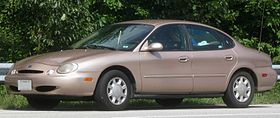| Ford Taurus (third generation) | |
|---|---|
 | |
| Overview | |
| Manufacturer | Ford |
| Production | June 19, 1995 – September 1999 |
| Model years | 1996–1999 |
| Assembly | Atlanta Assembly, Hapeville, Georgia, U.S. Chicago Assembly, Chicago, Illinois, U.S. |
| Designer | Doug Gaffka (1991, 1992)[1] |
| Body and chassis | |
| Class | Mid-size car[2] |
| Body style | 4-door sedan 5-door station wagon |
| Layout | FF layout |
| Platform | Ford DN101 platform |
| Related | Mercury Sable Ford Taurus SHO Lincoln Continental Ford Windstar |
| Powertrain | |
| Engine |
|
| Transmission | 4-speed AX4N automatic 4-speed AX4S automatic |
| Dimensions | |
| Wheelbase | 108.5 in (2,756 mm)[3] |
| Length | Sedan: 197.5 in (5,016 mm) Station wagon: 199.6 in (5,070 mm) |
| Width | 73.0 in (1,854 mm) |
| Height | Sedan: 55.1 in (1,400 mm) Station wagon: 57.6 in (1,463 mm) |
| Chronology | |
| Predecessor | Ford Taurus (second generation) |
| Successor | Ford Taurus (fourth generation) |
The third-generation Ford Taurus is an automobile that was marketed by Ford from the 1996 to 1999 model years. While the chassis underpinnings were largely carried over, the redesign gave the Taurus its first complete exterior redesign since its 1986 introduction. Slotted between the compact Ford Contour and full-size Ford Crown Victoria, the third-generation Taurus was again offered as a four-door sedan and as a five-door station wagon, marketed alongside the Mercury Sable.
In contrast to the evolutionary 1992 update of the second generation, the third generation sought to recreate the class-leading design introduced by the 1986 Taurus, also in response to the 1992 introduction of the Chrysler LH cars.[4] Following the 1986 introduction of the Taurus, the model line had gained two significant competitors — the Toyota Camry and Honda Accord (the latter of which, the Taurus had overtaken as best-selling car in the United States) alongside traditional GM and Chrysler-brand competition.[5] The first Ford to combine round headlights with composite-style housings, the third-generation Taurus adopted oval shapes for multiple design elements of the exterior and interior, including the grille openings, taillamps, the rear window (for the Taurus sedan and Taurus/Sable station wagons), and side window openings for the Taurus/Sable.
The model line was released for sale in late 1995; in contrast to the near-universal acceptance of the first-generation Taurus, the third-generation Taurus received mixed reactions from consumers.[6] For the 1996 model year, the Taurus remained the best-selling car in the United States; however, only 49% of the model line were sold to retail customers, with the rest nearly entirely supported through fleet sales.[4] For 1997, the more conservatively redesigned Toyota Camry overtook the Taurus as the best-selling car in the United States (a position it has held ever since).[7]
The third-generation Taurus was assembled by Ford at its Atlanta Assembly (Hapeville, Georgia) and Chicago Assembly (Chicago, Illinois) facilities.
- ^ Kerwin, Kathleen (24 July 1995). "The Shape Of A New Machine". Bloomberg.com – via www.bloomberg.com.
- ^ "1999 Ford Taurus Specifications-Vehix". Archived from the original on 2011-05-06. Retrieved 2012-03-14.
- ^ "1996 Ford Taurus Intro-04". Archived from the original on 2017-12-22. Retrieved 2017-12-16.
- ^ a b Cite error: The named reference
CG encyclopediawas invoked but never defined (see the help page). - ^ Cite error: The named reference
News96was invoked but never defined (see the help page). - ^ Cite error: The named reference
MWwas invoked but never defined (see the help page). - ^ Cite error: The named reference
detwas invoked but never defined (see the help page).